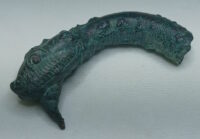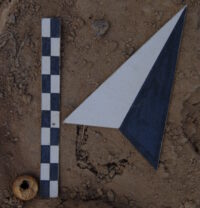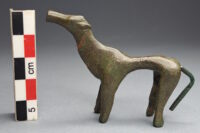 Rare artifacts from Greece’s Archaic Period have been discovered at the ancient sanctuary of Poseidon in Eliki, southern Greece.
Rare artifacts from Greece’s Archaic Period have been discovered at the ancient sanctuary of Poseidon in Eliki, southern Greece.
Eliki, also known as Helike, was found in the Late Bronze Age Mycenaean period (1600-1100 B.C.). According to legend, it was founded by Ion, the founder of the Ionian tribe of Greece, who named it after his wife. The city’s patron deity was Poseidon Helikonios, god of the ocean and of earthquakes, and a famous sanctuary to the god drew worshippers throughout the Archaic (750-479 B.C.) and Classical (479-323 B.C.) periods.
 Helike was destroyed by an earthquake and subsequent tsunami in 373 B.C. The city was submerged and its ruins remained visible under the waters of the Corinthian Gulf for centuries. It was a popular tourist destination for Roman travelers who toured its streets and statuaries from boats sailing above the submarine city. Ancient writers including Eratosthenes, Aelian, Seneca, Marcus Aurelius, Diodoros of Sicily and Pausanias visited the ruins and wrote accounts of Helike’s tragic fate. The submerged ruins were visible in the area until the 9th or 10th century. They were eventually buried under layers of river sediment.
Helike was destroyed by an earthquake and subsequent tsunami in 373 B.C. The city was submerged and its ruins remained visible under the waters of the Corinthian Gulf for centuries. It was a popular tourist destination for Roman travelers who toured its streets and statuaries from boats sailing above the submarine city. Ancient writers including Eratosthenes, Aelian, Seneca, Marcus Aurelius, Diodoros of Sicily and Pausanias visited the ruins and wrote accounts of Helike’s tragic fate. The submerged ruins were visible in the area until the 9th or 10th century. They were eventually buried under layers of river sediment.
 The Poseidon sanctuary complex was the center of the ancient city. An arched temple that dates to 710-700 B.C. has been unearthed in recent excavations, as has an altar made of rough-hewn bricks that dates to the 760-750 B.C. This season’s excavation focused on the area north of the arched temple, exploring the remains of two more buildings and uncovering evidence of religious activities going back to the 9th century B.C.
The Poseidon sanctuary complex was the center of the ancient city. An arched temple that dates to 710-700 B.C. has been unearthed in recent excavations, as has an altar made of rough-hewn bricks that dates to the 760-750 B.C. This season’s excavation focused on the area north of the arched temple, exploring the remains of two more buildings and uncovering evidence of religious activities going back to the 9th century B.C.
 One of the newly-unearthed buildings is an apsed temple that dates to the 8th century B.C. It is oriented north-south, unlike the apsed temple from the end of the 8th century that is oriented east-west. The other building is a temple-shaped structure dating to the 7th or 6th century B.C. Archaeologists found the stone foundation of the temple and four-sided bases believed to have belonged to the temple’s central colonnade. The floor is made of rammed earth.
One of the newly-unearthed buildings is an apsed temple that dates to the 8th century B.C. It is oriented north-south, unlike the apsed temple from the end of the 8th century that is oriented east-west. The other building is a temple-shaped structure dating to the 7th or 6th century B.C. Archaeologists found the stone foundation of the temple and four-sided bases believed to have belonged to the temple’s central colonnade. The floor is made of rammed earth.
 A large amount of pottery and other objects from the Archaic era (8th and 9th centuries B.C.) were found there, left as votive offerings to Poseidon. Recovered artifacts include a clay female figurine, clay chariot wheels, the bronze figure of an animal archaeologists think may be a dog but looks like a horse to me (Poseidon was worshipped in horse form too, which was the whole reason the Trojan Horse ruse worked), the bronze head of a snake, bronze buckles and pins and a gold bead from a necklace that is a very rare find.
A large amount of pottery and other objects from the Archaic era (8th and 9th centuries B.C.) were found there, left as votive offerings to Poseidon. Recovered artifacts include a clay female figurine, clay chariot wheels, the bronze figure of an animal archaeologists think may be a dog but looks like a horse to me (Poseidon was worshipped in horse form too, which was the whole reason the Trojan Horse ruse worked), the bronze head of a snake, bronze buckles and pins and a gold bead from a necklace that is a very rare find.
Copper and clay figurines, which served as offerings to the god, are thought to confirm that this was the famous site of worship of Helikonian Poseidon, but also suggest that a second deity was also worshiped at the same sanctuary.
This second deity is expected to be identified after further study of the new finds.
* This article was originally published here













No comments:
Post a Comment